|
The Homo Erectus
Variation of the Caro-Kann Defense, Part I Okay, as I promised three
months ago, I am finally going to start revealing some of Dana's Secret Chess
Files! You will get to see some of my home-brewed openings. Before we start, you
might want to re-read
Dana's
Opening Philosophy.
The first line I want to look at is Dana's Home-brewed Response to the Caro-Kann.
This one is somewhat exceptional in two ways. First, it's by far my most
successful opening experiment. I have played it in 18 tournament games, with a
record of +13 -3 =2, or a 78 percent winning percentage. Second, this one is
more anti-positional than most of my pet lines. As I said in Dana's Opening
Philosophy, I like to look for solid developing moves that for some reason
aren't the most popular. But this definitely does not fit into that category.
Against the Caro-Kann, my pet variation is 1. e4 c6 2.
d4 d5 3. e5 Bf5 4. g4!?
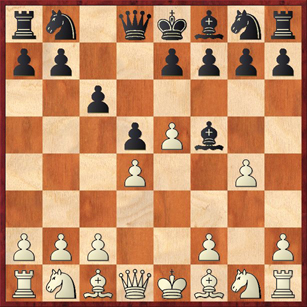
What is this foolishness? The key point of this variation is that it is based
as much on psychology as on actual chess principles. Back in the early 1980s,
when I started playing this line, there was a well-known book called
Real Men Don't Eat Quiche, which I've never read, but which gave rise to the
expression "quiche-eater." A quiche-eater is a wimp, or as Wikipedia says, a
person who "lacks masculine virtue." In other words, not a "real man."
So one day it hit me: Caro-Kann players are the quiche-eaters of the
chess world. They are not looking for a fight. If they were, they'd play a
"real man" opening like the Sicilian Defense or any of the 1. e4 e5 openings.
They want a nice comfortable game that they can draw or perhaps squeeze out a
win in the endgame. So how do you play against someone like that? You upset
them. You throw the kitchen sink at them. Because their primary characteristic
is aversion to risk, you have to drag them, kicking and screaming, into highly
risky positions. And therefore you play 4. g4.
I admit that this move is awfully reminiscent of the Grob (1. g4). It creates
giant weaknesses in White's kingside and does nothing for White's development.
But I do think it's a little bit better than the Grob, because the move 4. g4
comes with a gain of tempo, and also because White has staked out a big claim in
the center.
I think that the best way to get our feet wet in this variation is to look at
a model game, where White gets everything that he could hope for. The game I
will show you is Mackenzie - Collier, from the 1987 North Carolina Championship.
(Incidentally, this game helped me win my second state title!) If memory serves
me correctly, Collier was a class A player (1800-2000).
What is White hoping for? First, a very thematic idea is to chase Black's
bishop off the c8-h3 diagonal and then play e6, a move that throws a monkey
wrench in Black's development. Another theme is to weaken Black's light squares
on the kingside. This is a rather surprising development for the Caro, because
Black's light squares are usually pretty solid. But in this line, White hopes to
exchange off Black's bishop and further weaken Black's kingside by taking the
f-pawn (e5-e6-f7) or by forcing the f-pawn to take something else (... f7xe6 or
... f7xg6). Another objective (not always achievable) for White is to prevent
Black from castling queenside -- to flush his king out before he has a chance to
reach safety. Finally, another idea (rarely achievable) is to push the pawn to
g5 and constrict Black's kingside development, as in some lines of the Grob.
Let's see how I accomplished most of these objectives in the game Mackenzie -
Collier.
4. ... Bg6 This move is probably slightly
worse than the alternatives, 4. ... Be4 and 4. ... Bd7, because it offers less
resistance to White's plan. We'll cover those other two moves in later entries.
I don't think that 4. ... Bg6 is objectively bad, though. My record against it
is +3 -0 =1, but in most cases it wasn't the opening that won it for me -- it
was my opponents' quiche-eating tendencies.
5. e6 ... Strangely enough, this is the only
tournament game where I've played this consistent followup. One time I played
the not very impressive 5. Nf3 e6 6. Bg2 h5 7. h3, where White is actually
looking more like a quiche-eater than Black. The other two times I interpolated
5. h4 h5 and then played 6.
e6. However, neither of these really led to an advantage. Mackenzie-Couvillion,
1987, went 6. ... Qd6 7. ef+ Bxf7 8. Nf3 hg 9. Ne5 Bh5 10.
Be2 Nf6 11. Nxg4 Nxg4 12. Bxg4 Bxg4 13. Qxg4 (diagram).
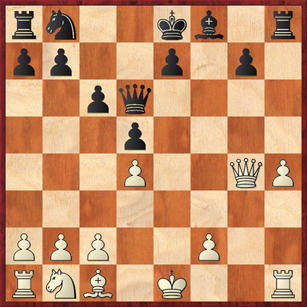
I like the activity of White's queen, and I have succeeded in weakening the
light squares a bit. On the other hand, White's kingside is rather a mess, and I
don't think that White can realistically claim any advantage. Black lost by
playing too passively and never striking at White's center with ... e5 or ...
c5. The other game, Mackenzie - Nash 2002, diverged with
8. ... Nd7 9. g5 O-O-O 10. Bh3 e6 11. O-O Ne7 (diagram)
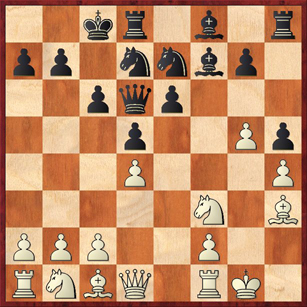
The trouble for White is that Black is eventually going to play ... Ng6 and
... e5, freeing his position. How to stop this? I decided on the really dubious
move 12. Ne5?! My reasoning was that Black, being a
quiche-eater, is not likely to accept the pawn with 12.
... Nxe5 13. de Qxe5. I was right about that, but unfortunately Black
found the superior move 13. ... Qb4! And now Black
clearly has an advantage, in view of White's weak pawns (especially the h4 pawn)
and lagging development. The game was eventually drawn, though.
All in all, it seems to me from these examples that the interpolation of 5.
h4 h5 hurts White more than it helps, so I think that 5. e6 straight away is
probably the best. Now back to our model game.
5. ... fe?! To my mind, this move is too
cooperative, even though Fritz ranks it about even with 5. ... Qd6.
6. Nf3 Be4? It's tempting to pin the knight, but
it just wastes tempi with the bishop. Black should continue developing with 6.
... Nd7, which is the computer's top recommendation. The computer then
recommends 7. Ng5!? e5 8. de, but now Black should not recapture with 8. ...
Nxe5? because of 9. f4 followed by 10. f5 Bf7 11. Nxf7, and White achieves his
objective of preventing Black from castling queenside. All of this is completely
untested -- make of it what you will. But just remember, even if the lines are
wild and woolly, you're playing an opponent who probably doesn't like wild and
woolly chess, so you already have the psychological advantage.
7. Nbd2 Qa5 8. c3 Bxf3 9. Nxf3 ...
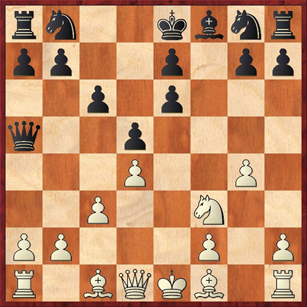
Things are already looking pretty bad for Black. 9. ... Nd7 would be met by
10. Qe2 and 11. Ng5. He finally decides to give back the pawn in order to
mobilize his kingside.
9. ... e5 10. Nxe5 Nd7 11. Nxd7 Kxd7 White
has achieved one of his objectives -- prevent queenside castling!
12. Bh3 e6 13. Qf3! Qd8 This didn't surprise me
because it is the only way to keep White from winning a pawn with 14. Qf7+.
However, Black should just give up the pawn with 13. ... Bd6. Mobilizing the
pieces is more important than maintaining material equality.
14. g5 Qe8 15. O-O Qg6 Notice that because of
all these queen moves, Black is not finishing his development! That omission
will eventually cost him the game.
16. Re1 Re8
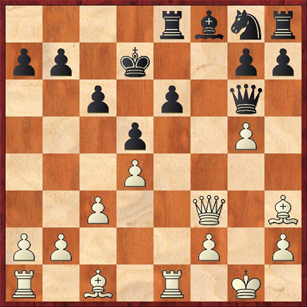
White to play and win.
I was pretty pleased with the following combination, which is a nice way to
cash in on Black's exposed king and lack of development.
17. Rxe6! Rxe6 18. Qxf8 Qh5 There's not much
Black can do, with all of these pins -- the pin on the e6 rook and the g8
knight. He attempts to break one of them, but now his position collapses.
19. Qxg7+ Ne7 20. Bxe6+ Kxe6 21. Bf4! There's no
need to take the rook! The threat of 21. Re1+ is a killer, and if Black plays
21. ... Re8 or 21. ... Qe8 to defend the knight, then it's mate in three after
22. Qf6+.
Black resigned.
Next time we'll take a look at the 4. ... Be4 variations. |
